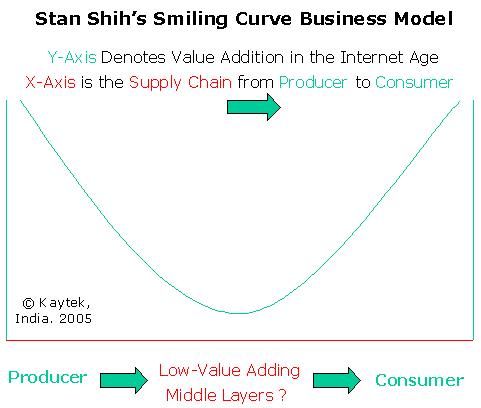 Understanding The Smiling Curve Model to Evolve Business Strategies in the Internet Age
Understanding The Smiling Curve Model to Evolve Business Strategies in the Internet Age One of the ideas that we find useful to understand Business in the Net Age is the 'Smiling Curve' which is a Business Model introduced by Acer Group Chairman Stan Shih. Acer (now renamed Benq) is a large High-Tech Manufacturer from Taiwan and at one point in time had billions of dollars of sales In India, our organization's hardware division was earlier one of the value added partner of their high-end computer servers in Mumbai (Bombay).
In our opinion, The 'Smiling Curve' is one of the Business Models, which accurately depicts Business Value Addition in the Internet Age.
Visualize an X-Y Axis with a Smiling Curve moving from Left to Right.
The Y-Axis represents the Value Addition.
The X-Axis depicts a typical Producer Distribution Channel Consumer Supply Chain with the 'Producer' on the left and 'Consumer' on the right side.
So, the two ends of the 'Smiling Curve' depict high value addition with a low value addition in the middle. Early stages of computerization made middle-management layers redundant and irrelevant within organizations.

As per this model, The greatest Value Addition in any Product, Service or Idea happens either at the 'Creation' stage on the left hand side of the 'Smiling Curve' or at the 'Consumption' Stage on the right hand side of the 'Smiling Curve'.
The region in the middle between the 'Producer' and the 'Consumer' has the least value addition.
The Internet has drastically shortened the Gap between the 'Builders' and 'Users' of any Product, Service or Idea, irrespective of geography, nationality or hierarchy.
Middlemen who find themselves squeezed in between the producers and consumers will have to seek new ways of adding value. e.g. Airline Travel Agents whose commissions have been cut by airlines will need to devise innovative strategies to create value for their customers.
Similarly, traditional matrimonial service bureaus and real estate agents in India are finding themselves increasingly irrelevant in the Internet era unless they modernize and automate their systems & processes.
This is happening uniformly across the globe.
As a small example, two the largest retailers in the world Walmart and the French Giant Carrefour came to India seeking contacts with Only Direct Manufacturers.
Without any agents or middlemen in between who could supply to them as per their exacting specifications.
Dell and CISCO are other best known examples of large organizations that have epitomized the practical implementation of the 'Smiling Curve' Model.
To our minds, understanding the 'Smiling Curve' is key to evolving effective Business Strategies in this Internet Age.
It underlines the key value addition Role that individuals and organizations can play in this global internet economy.
That Of innovating to provide a distinctive unique product or service at the best possible price & service levels.
 A Kaytek Web Consulting Insight
A Kaytek Web Consulting Insight 